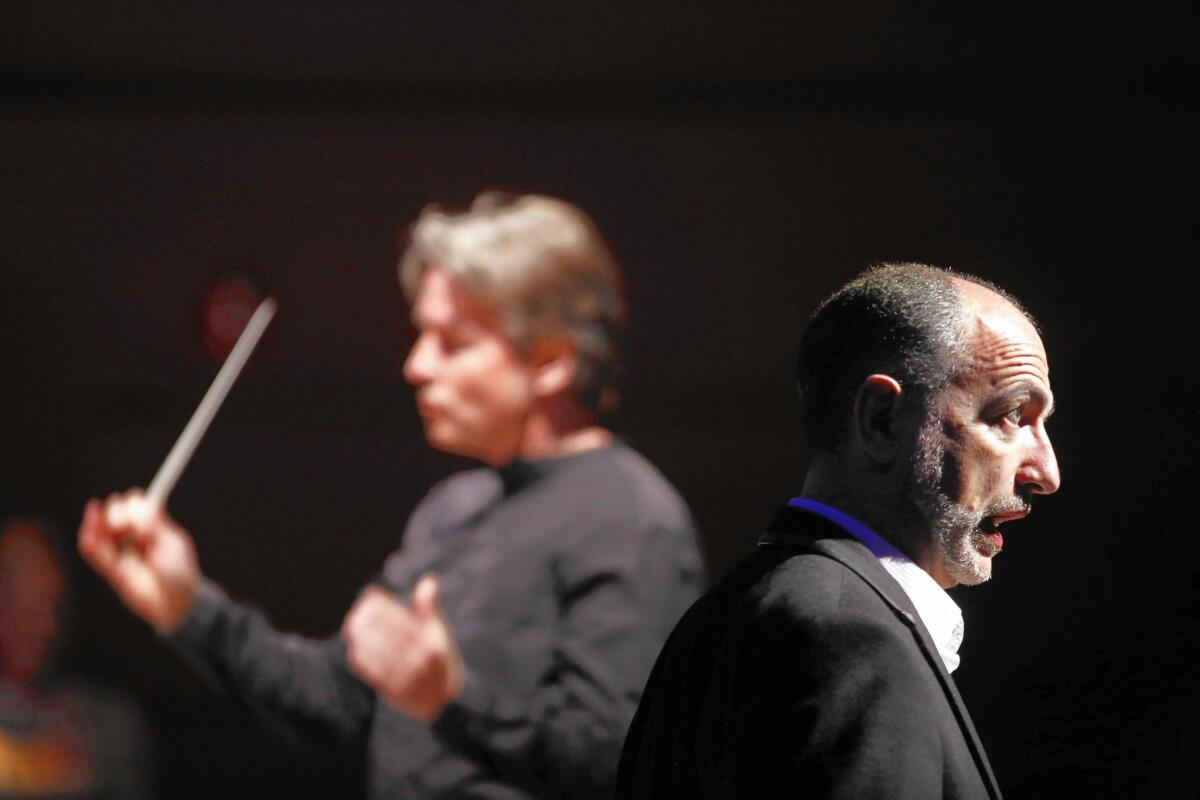Review: Asian inspiration as L.A. Philharmonic tackles ‘Pelléas’; Pacific Symphony ‘Turandot’

- Share via
We credit Asia too little with its role in the rejuvenation of opera in the early 20th century, especially in France and Italy. Not long after hearing a Javanese gamelan, Debussy set about to compose his seminal “Pelléas et Mélisande,” completed a decade later in 1902.
Around two decades later, Puccini, Debussy’s Italian contemporary, having exhausted the predictable melodrama of verismo opera, announced that it was time to strike out on new paths. He turned to China for enlightenment in “Turandot.”
Both operas offered a new way of thinking about music and theater, of sound and structure, of affect and effect. The most telling newness was not in the singing or on the stage but in the pit. Wagner had used musical motives in the orchestra as a psychological motivator, but Debussy and Puccini turned to physical magic of pure sound to enhance dramatic perception; that changed everything.
What are the odds that last weekend the Los Angeles Philharmonic would present an ambitious, orchestra-centric, semi-staged performance of “Pelléas” at Walt Disney Concert Hall and the Pacific Symphony would do the same with “Turandot” at the Renée and Henry Segerstrom Concert Hall? The mysterious working of zeitgeist can be the only explanation. There is something going on with these works that gives us understanding of our own multicultural musical world. That something is difficult to fully appreciate in the opera house. You need the orchestra front and center.
Played with luminous beauty yet also gripping intensity by the L.A. Phil under Esa-Pekka Salonen in the illuminating Disney acoustics, “Pelléas” felt like a once-in-a-lifetime event Friday night. The concert was the centerpiece of the orchestra’s “City of Light” festival (which ends Tuesday with a chamber music program), but the import went far beyond cosmopolitan Paris.
Based on a symbolist play by Maurice Maeterlinck, the opera is long, slow, mysterious and uneventful. An enigmatic young woman is found in the forest and brought home by an older prince, Golaud, who marries her. Her love affair with Golaud’s young half-brother, Pelléas, ends in tragedy, Maeterlinck proposing that all life turns on suffering.
Vocal lines are naturalist, not operatic. The brilliance of Debussy’s orchestral writing is that it explains nothing but suggests everything in colors and harmonies and moody themes. We feel the presence of the nature and humanity but not the workings. Western logic gives way to Eastern acceptance.
Salonen emphasized the physicality of sound — an oboe’s oboeness; a harp’s harpness. Gloom pervades “Pelléas” but the strings could evoke radiant beauty as a complement to radiant sadness. The singers — led by Camilla Tilling’s chary Mélisande, Stéphane Degout’s passionate “Pelléas,” Laurent Naouri’s understated Golaud and Chloé Briot’s ragamuffin Yniold (Golaud’s son) — were vocally strong.
But David Edwards’ staging treated them as a soap-opera crew. Pretentious, unclothed mannequins decorated the chorus benches. No one dressed well. A cheesy prop (crown, wig, sword) on a cheesy pedestal set the scenes. Edwards, at least, couldn’t rob veterans Willard White (Arkel, the old patriarch), and Felicity Palmer (Genevieve, Pelléas’ mother) and actress Kate Burton (who read from Maeterlinck to introduce each act) of their tremendous dignity and poise.
The Pacific Symphony’s motivation for “Turandot” seemed to be the Chinese New Year. The Segerstrom lobby was decorated with lanterns and dragons. Inside, the orchestra was placed on two levels of the stage, with gongs and percussion on a platform that made them dominate in exciting and important ways. The next level up was a semi-circle for the chorus. Above that, a curved screen served for projecting various kinds of graphics, animations and what looked like a trailer for a kung fu film of dubious provenance. At the highest point was a screen for the surtitles.
Where to look? What to look at? The staging by Eric Einhorn tried everything. Dancers used music stands as swords. The comic characters Ping, Pang and Pong were meant to be orchestra players. Otherwise, the cast was dressed in old-fashioned opera costumes, vaguely Chinese, vaguely modern, and relied on the laughable conventions of the provincial Italian opera a century ago.
All the interest was in the orchestra. The Pacific Symphony’s music director, Carl St.Clair, led a brashly American performance of the opera, continually drawing attention to his flamboyant conducting.
The composer had looked East before in “Madame Butterfly,” but then he was a sentimental Italian traveler. China, however, offered characters who, like Maeterlinck’s, are best left inexplicable. Thus by enthusiastically stressing Puccini as a venturesome 20th century percussion composer, St.Clair got across that musical ah-ha moment in a way that it can rarely be felt in the opera house.
On the other hand, any attempts to bring the opera house into Segerstrom proved downright peculiar. Tamara Mancini as the ice princess, Turandot, Marc Heller as the ardent lover Caláf and Elizabeth Caballero as the heartstring-tugging slave girl Liú had strength, stamina, ardor and heaps of gushy vibrato. They were one world. The orchestra, another. The visuals, a third. Dancers constituted a fourth. There were others.
Children clumsily paraded down the aisles carrying lanterns and blocking the view of stage for some. An organist distracted herself up in the loft during a climax in the action. So it went. But the orchestra was strong enough to somehow dominate, to sound and — unlike everything that surrounded it — come across as current and significant.
Was this jaw-dropping muddle a bad thing? Maybe the whole shebang serves to represent the messiness of new paths with China, modern or ancient, as well as our enduring enchantment with finding them.
More to Read
The biggest entertainment stories
Get our big stories about Hollywood, film, television, music, arts, culture and more right in your inbox as soon as they publish.
You may occasionally receive promotional content from the Los Angeles Times.











